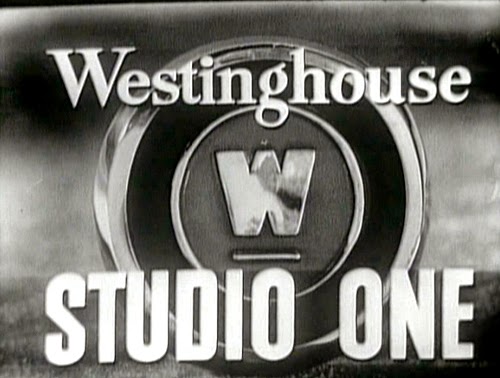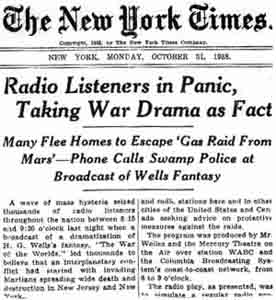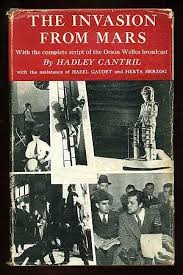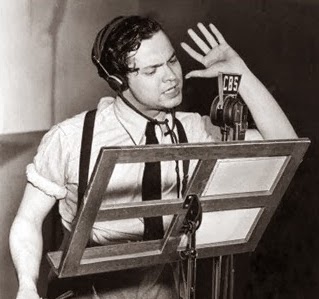IMDb meta-data runtime is 55 minutes, rated 6.9 by 92 cinemitizens.
Genre: Docudrama.
An episode of the long-running CBS television program ‘Studio One.’ It combines narration by Murrow with re-enactments.

Verdict: When Ed Murrow speaks, I listen.
In this case it is a dramatisation of a CBS radio broadcast in 1938 of a story published 1898 in Great Britain. The result was headline news across the United States and the world. Huh?
On Halloween night, October 30, 1938, Orson Welles’s Mercury Players of the Air performed an adaptation of H.G. Wells’s ‘War of the Worlds.’ It took the form a news report, including a reporter in the field at Grovers Mill in New Jersey. We see all of this being simulated in the CBS radio studio.
Those who heard the broadcast and reacted included a teenage babysitter, card playing college boys, patrons at a neighbourhood bar, and a police officer at a switchboard. Some people went nuts. Others ran amok. Others loaded shotguns. Many hid under the bed. Some fled. Fleeing was hard since no one knew where Grovers Mill was. All of this in response to a radio broadcast.
The next morning the ‘New York Times’ thundered the news of the national panic caused by the broadcast!

Why the panic?
The program was advertised long in advance in newspapers and magazines. The newspaper radio listings, including those in the ‘New York Times,’ clearly identified the program as an entertainment. The on-air introduction made that clear, too.
However, ‘The Mercury Players of the Air’ was a sustaining program owned by the CBS network. It had no commercial sponsors so there were no commercial breaks. It ran straight through for one hour. Once it started off it went, and as later research found, many people were dial surfing and missed the introduction and had not read the listings but tuned in part way through.
Many a PhD has since dined out on the aftermath. Was there really a panic? Whoa, here comes the Four Horses of Definition. What explains the reaction? Sociological, psychological, dietary, demographic, ethnic, swamp gas explanations have all been seriously offered and seriously considered in PhD dissertations. Faux News denies it ever happened or Hillary did it. One or the other.
Murrow put the programming in the context of the news of 1938 from Europe and Asia. In the East Japan was devouring Formosa, Korea, Manchuria, China, and Shangri-la. From Europe the air fleets of Nazi Germany featured in every movie newsreel. It had re-occupied the Rhineland. Seized the Saar basin. Anschlussed a very willing Austria. Carved the Sudeten out of Czechoslovakia only a few days before with goose-stepping automatons.
Pundits were describing ever more terrible weapons of modern war beneath the seas and from the skies. These combined with memories of chemical weapons in the Great War. What a brew!
For some auditors, who missed the newspaper advertisement, the program listings, and the introduction, the descent on Grovers Mill might well have been the spawn of Naziism. To listen to the broadcast now there are only a few gasped, terse descriptions of the Martians and someone in distress might not fathom those. Or just conclude that these were the creatures of the Asiatic Japanese or Satanic Naziis.
That was one of the findings of Hadley Cantril’s ‘Invasion from Mars: A Study in the Psychology of Panic’ (1940): Many who heard part of the broadcast were prepared for catastrophe by all the bad news that just kept coming.

These prepared people had endured the unimaginable for a decade: the Wall Street Crash, the Great Depression, the Dust Bowl, armies of the unemployed, starvation, diseases out of control, along with the Asian and European political news. The times, they were apocalyptic.
The story is that Cantril in Princeton heard the broadcast and then read the ‘New York Times’ the next morning, and mobilised the research project within hours to identify and interview auditors. Quite impossible today with months of Ethics Committee vetting, budgets laid down years in advance, KPIs that suit research managers, corporate plans, the annual cycle of research grants, and more.
But now back to the film, there is a raft of new faces in the re-enactments, including Ed Asner, John Astin, Warren Beatty, James Coburn, Vincent Gardenia, and Warren Oates. Babysitter Susan Hallaran eats the wallpaper as they say in show biz, though this was her last credit on the IMDb.
Alexander Scourby is the radio announcer with the mellifluous voice, and he carries the show on radio. The son of Greek immigrants who learned English from Shakespeare.
But the star of the show is neither named nor given any lines: Orson Welles.
 The wunderkind at work that very night.
The wunderkind at work that very night.
He wanted nothing to do with this reprise. Whether the broadcast caused a panic, there was a sizeable reaction to it. CBS was cross-pressured because on the one hand it wanted the acclaim of such great influence (to lure advertisers in the future) but it wanted no part of the complaints. It did what every large organisation still does and delegated responsibility downward. The fact that Welles, for once, had done everything through channels and had approvals all the way to the top, was conveniently forgotten by the professional amnesiacs of management in CBS. Such amnesia is surely the subject of one McKinsey management seminar.
It was left to Welles alone to eat a lot of crow by way of apology. This was not something that came easily to this mercurial Zeus, and he had no wish ever to re-visit it. That is, he never wanted anything to do with CBS again, as Murrow obliquely noted.
The gossip on the inter-web is that H. G. Wells and Orson Welles met a year later in San Antonio Texas where each was on a speaking tour. Hope they stayed in a better hotel there than I did once upon a time.
Murrow’s documentary makes no mention of the 1953 film. Yet it would have come to mind for many in the audience. There are several other documentaries about the broadcast, one or two with similar titles.
